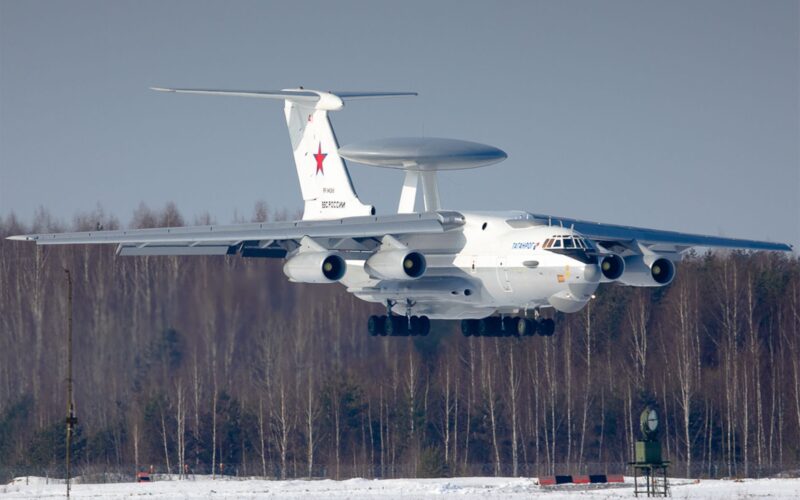A Beriev A-50 airborne early warning and control (AEW&C) aircraft, that was allegedly damaged by Belarusian resistance members, was attacked with drones, the country’s opposition activists have claimed.
Two drones with explosives were used in the attack, one of which damaged the aircraft’s radar, while the other hit the cockpit, the activists said.
The attack was first announced in the afternoon of February 26, 2023, on social media channels belonging to ByPol, an organization comprising former Belarusian security officers who oppose the pro-Russian regime of official Belarusian President Alexander Lukashenko.
According to ByPol, two explosions were heard at the Machulishchy air base and were followed up by the increased activity of Belarusian security services in the area.
Later the same day Belarusian oppositional news website BelSat published an interview with Alexandr Azarov, a retired Belarusian police lieutenant colonel and the head of ByPol.
“It was drones. The operation was performed by Belarusians, members of the “Peramoha” plan. They are now safe outside of Belarusian borders,” Azarov is quoted as saying by BelSat.
According to Azarov, the aircraft was heavily damaged in the attack and “is not going to fly anywhere”.
An alleged attack
So far there has been no independent confirmation of the attack, nor damage inflicted on the aircraft.
According to Belarusian Hajun Project, which monitors resistance activity to Russian forces in Belarusian territory, the attack was performed with drone-dropped munitions.
An A-50, registration RF-86843, which arrived at Machulishchy air base at 18:33 local time (3:33 PM GMT) was attacked, according to the project’s website, which refers to insider sources.
The website also lists several reports from local residents who heard the explosions and noticed an immediate ramp-up in the presence of security forces around the airport.
Belarusian militia and the personnel of special purpose police detachment “OMON” began to stop cars and check the documents of residents in the Machulishchy area the same evening, messages from local Telegram chats show.
According to Belarusian Hajun, local law enforcement personnel later found a bag containing the remotes that were used to control the drones.
Official Belarusian news channels did not publish any news about the alleged attack. According to Belarusian media, an urgent meeting of high-ranking security officials was called in the morning of February 27.
Meanwhile, Dmitry Peskov, the spokesperson of Russian president Vladimir Putin, said he had “nothing to say” about the alleged attack and added that Belarusian sources had denied it took place.
Several pro-Russian military influencers commented that they were able to confirm the attack, although they did not provide details about its target, or the extent of the damage caused.
Russian AWACS
The Beriev A-50 is the main airborne early warning and control (AEW&C) aircraft of the Russian Aerospace Forces. It is based on the Ilyushin Il-76 military transport and is largely similar to the Boeing E-3 Sentry Airborne Warning and Control System (AWACS) used by the United States and NATO countries.
Introduced in the 1980s, the A-50 carries Vega-M surveillance radar in a rotordome above its fuselage. According to Russian sources, the Vega-M can track up to 150 airborne targets at the range up to 200-600 kilometers (125-373 miles) depending on the target’s altitude.
A-50 aircraft, operated from air bases within Belarus, have been performing surveillance flights to support the operations of Russian forces since the early days of the full-scale invasion of Ukraine.
According to the Ukrainian authorities, the aircraft were used to direct Russian fighter jets on intercept and attack missions, including the launch of Kinzhal hypersonic missiles.
According o data from the International Institute of Strategic Studies Military Balance 2022, at the end of 2021, Russian Aerospace Forces had six operational A-50Us that had undergone a modernization program since 2011, as well as three unmodified A-50s.
In February 2022 Russia also began testing the Beriev A-100 Premier, a new AEW&C aircraft intended to replace the A-50.
In his interview with BelSat, Azarov claimed the RF-86843 was not the only A-50 operated from Belarusian territory, although the exact number of such aircraft involved in Russia’s invasion of Ukraine was not yet known.
Earlier reports by Belarusian Hajun claimed that another A-50, registered RF-94268, was regularly flown from Machulishchy during the first half of 2022. According to reports from February 2023, that aircraft remains based in Belarus.
UPDATE 02-27-2023, 17:40 (UTC +3): In the afternoon of February 27, 2023, Russian news websites and Telegram channels began to publish claims that, according to unnamed sources, the attack was performed by drones launched from Ukrainian territory. The reports claim that six drones were launched, four of which were shot down, while two hit the air base, setting a Belarusian Air Force plane on fire and damaging a Russian Aerospace Forces A-50.
The incident was also mentioned by the Speaker of the Air Forces Command of the Armed Forces of Ukraine Iurii Ihnat in his media address. Ihnat called the attack “good news” and said that he trusts the reports about the attack.

